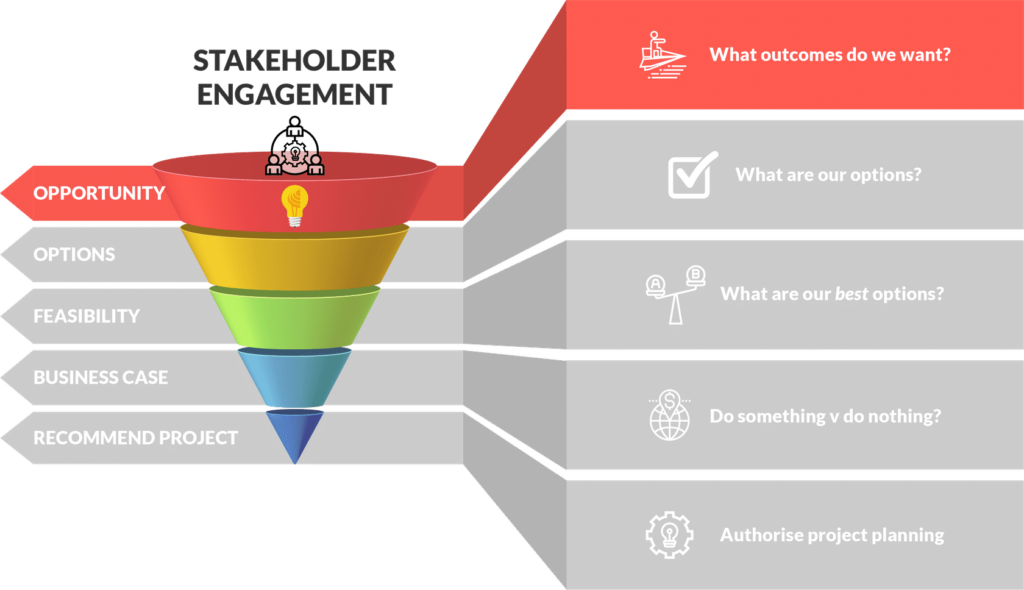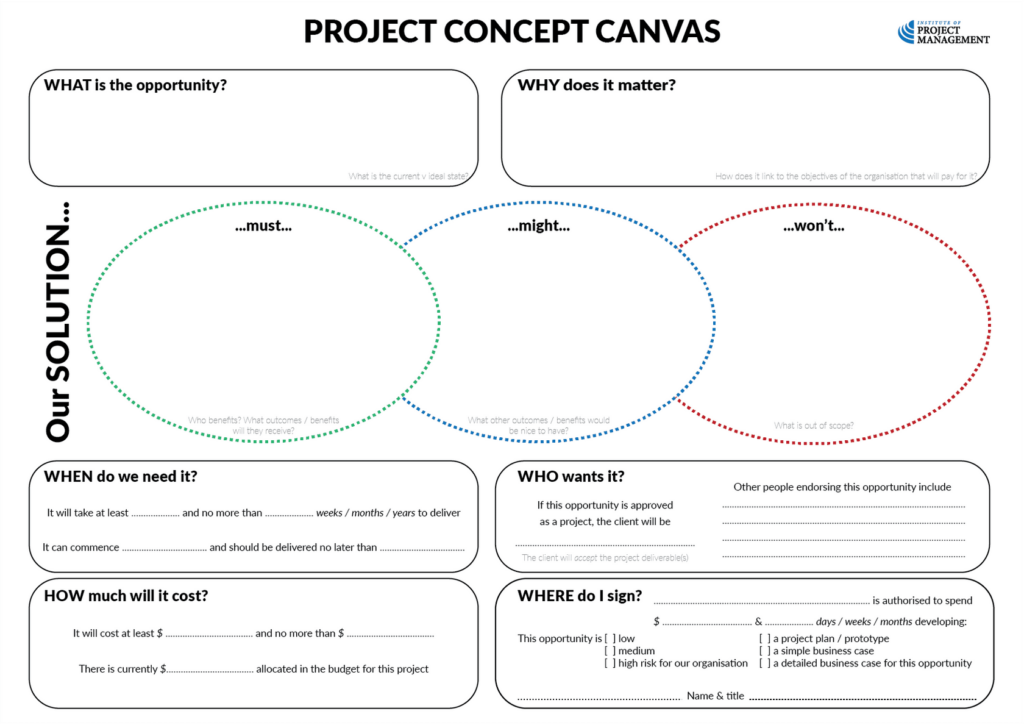
If I had only one hour to solve a problem, I would spend up to two-thirds of that hour in attempting to define what the problem is.
Unverified quote, popularly attributed to Albert Einstein
Problem seeking (and solving)
So, you have a great idea – how do you effectively communicate it to others, ideally to the point they might be willing to invest in it?
The first step in bringing a project to life is to make our idea a solution to their problem.
Most organizations will have published somewhere a great list of unsolved problems; although they might call this list their strategic objectives or goals.
These unsolved problems are more often than not found in an organization’s strategic plan or on the “About Us” page on their website.

But even if these goals are not published, you can often deduce them from the nature of the organization and the business it is in.
Goals as unsolved problems?
Well, yes – each goal is a statement by the organization of what they want to achieve; however, it is (on its own) usually silent about how it will be achieved.
Every project an individual or organization undertakes is therefore intended in some way to support or satisfy their objectives, whether they be personal objectives (such as more free time), commercial objectives (such as greater profit), or community objectives (such as more liveable cities).
Therefore, it is absolutely critical to its success that your project be understood as a means of realizing these objectives and not an end in itself.
For that reason, we link the project’s outputs and outcomes to the objectives of the sponsoring organization right from day one.
The project concept canvas
A project concept canvas is a simple, visual, and effective way to define project opportunities.
The purpose of the concept canvas is to provide organizations with a low-cost, standardized way of comparing opportunities.
Stakeholders who identify opportunities are encouraged to put them forward for consideration using the listed fields on what is usually a one-page document.
Organizations use the concept canvas to make efficient and effective priority decisions about:
- which opportunities to advance to more detailed (read: expensive) analysis
- which opportunities need to go back for more conceptual development, and
- which opportunities to drop (before any more time and money is invested in them).

What is the opportunity?
When describing the opportunity, you should contrast the current state of affairs with an ideal future state.
You should also use positive phrasing in your description.
Instead of using the language of problems (for example, our project teams are not very productive), highlight the benefits (by recognizing and rewarding high-performing project teams, we can improve overall productivity).
Why does it matter?
Here is where you link the opportunity (and outcomes, below) to the strategic objectives of the organization you are presenting this to – the one you would like to pay for it!
As stated earlier, an organization’s objectives can often be found in its strategic plan or inferred from what it does on a day-to-day basis.
Objectives may also include cultural goals, such as values or behaviors that the organization aspires to, or more detailed goals such as the key performance indicators (KPIs) set out in a department or team’s annual plan.
Explicitly reminding decision-makers of why this opportunity matters to the business is a great way of promoting the relative importance of your potential project.
Our solution must…
Instead of focusing on the project deliverables (outputs), focus here on what outcomes or benefits the project will realize post-delivery.
In other words, instead of proposing that we give our high-performing project managers a cash bonus, list here the benefits that giving high-performing project managers a bonus will bring to the sponsoring organization.
For example, by giving bonuses, we expect to improve project performance, retain good project managers for longer, attract better project managers when we advertise for new staff, and enhance corporate culture.
It’s okay if you don’t capture every outcome on the concept canvas, or even if some outcomes end up being unrealistic. It is far more important that you don’t lock yourself into a project solution at this stage (for reasons that will become obvious in this Unit).
Our solution might…
Not every outcome might be realistic for your opportunity.
Here you could list some ‘nice’ to have (as opposed to ‘need’ to have) benefits that may result from realizing this opportunity.
A nice-to-have outcome from our bonus example might be improving the overall morale of the workplace if projects are more successfully delivered.
PRO TIP: Brainstorm benefits before you decide whether they are ‘must’ or ‘might’ have outcomes for your solution!
Our solution won’t…
Now, you should start to explicitly address what is out-of-scope of your opportunity.
In other words, what (possibly related) problems are we not trying to solve here?
For example, in recognizing and rewarding high-performing project managers, we are not looking to incentivize people for merely fulfilling the duties of their job description, and we may choose for now to limit the program to people delivering projects over a particular value (for example, $500,000+).
Ruling things out-of-scope assists decision-makers by clarifying what exact problem your solution is intended to address.
When do we need it?
As soon as possible!!!!
Be realistic about when and by when you need this opportunity to occur.
Although you might feel the need to create a sense of urgency by explicitly naming start and end dates, being too rigid this early in the project development phase may alienate potential backers.
Instead, propose a reasonable time frame for project delivery – between 6-12 months, as an example – making doubly sure you leave enough time for the decision-makers to go through the necessary approvals process.
How much will it cost?
As with time, provide a range of cost estimates that keeps as many options open as possible.
Ideally, you should propose a cost estimate within ±30-50% of a median price.
For example, the project should cost between $50,000 and $75,000.
If you under-estimate here, you may not have enough money later to realize your opportunity; however, if you over-estimate potential costs, the opportunity may be viewed as too expensive to pursue.
Organizations might also put aside money in their annual plans for as yet undefined projects – if that is the case, you should document the amount here. Sometimes, there is a big difference between what was allocated and what the project will actually cost!
Who wants it?
Alright! Stakeholders!! You know what to do here 🙂
It is firstly important to note who is the client requesting the project.
You can then start to list some of the high-power / high-interest stakeholders who support your project.
Although the list does not need to be comprehensive at this early stage, you may want to reference your organization’s stakeholder taxonomy to ensure none of the major players are missed.
A robust list of supportive stakeholders should start to give your investors confidence that the opportunity is achievable and that you are the right person to see it through – especially if you have had some initial conversations with them.
Where do I sign?
If your opportunity is accepted, an approved decision-maker will sign on the dotted line.
Don’t get too excited, though – your project is not yet approved!
Depending on the level of risk attached to the opportunity (something we look at in the next topic), this approval authorizes you or an in-house business analyst to prepare an appropriately detailed business case for more comprehensive and formal approval.
This approval is necessary, as preparing a robust business case depends on a significant commitment of organizational resources.
These resources should only be expended on opportunities that pass this first semi-formal test of the proposal’s value.
Yet even if a business case is not required, acceptance of the opportunity would only authorize the commencement of the planning phase, again, with an appropriate commitment of time and money.
Listing these resources and the person responsible for their use completes the final section of the concept canvas.
Click here to download a free-to-use PDF copy of the project concept canvas.




